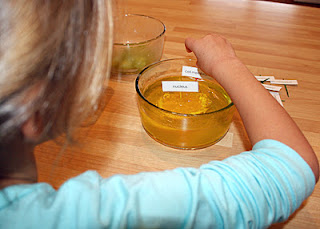We finished up our brief study of cells this week by determining the differences between plant cells and animal cells. Tessa also learned the name and function of select cell parts of each.
Friday
- Completed RSO Cell Lab 2: Plant and Animal Cells Differ.
- Watched "Cells" music video by They Might Be Giants via YouTube.
- Watched The Magic School Bus: Goes Cellular by Scholastic via YouTube.
I'm not much of a music buff, so my discovery of the band They Might Be Giants is probably way old news for most people. I came across one of their videos entitled, "Cells" while searching YouTube last night. I played it for Tessa today. She absolutely loved it! We watched it at least ten times. (Remember, if you have cruddy internet access like me, use SaveVid to download YouTube videos to your hard drive, then play them without interruption later.)
Other Resources of Interest
* RSO = R.E.A.L. Science Odyssey
Fruit and Gelatin Cell Models
Cell Lab 2: Plants and Animal Cells Differ is a great little hands-on lab. It requires just a few simple ingredients besides basic household supplies...gelatin, green grapes, an orange (or strawberry) and toothpicks. Since the gelatin is to be softly set, I prepared it and sliced the fruit the morning of the lesson.
Other Resources of Interest
- "Animal and Plant Cells" free printable diagram from Education.com.
- Evan-Moor ScienceWorks for Kids, Grades 4-6+: The Human Body "Cells Are the Fundamental Unit of Life" unit (just the animal and plant cell diagram) from TeacherFileBox.com.
* RSO = R.E.A.L. Science Odyssey
Fruit and Gelatin Cell Models
Cell Lab 2: Plants and Animal Cells Differ is a great little hands-on lab. It requires just a few simple ingredients besides basic household supplies...gelatin, green grapes, an orange (or strawberry) and toothpicks. Since the gelatin is to be softly set, I prepared it and sliced the fruit the morning of the lesson.
 |
| Tessa pushed orange slices and grapes into lemon-flavored gelatin. The oranges represented nuclei and the grapes stood in as chloroplasts (for the plant cell). |
 |
| Tessa labeled the parts of her fruit and gelatin cell models. |


No comments:
Post a Comment